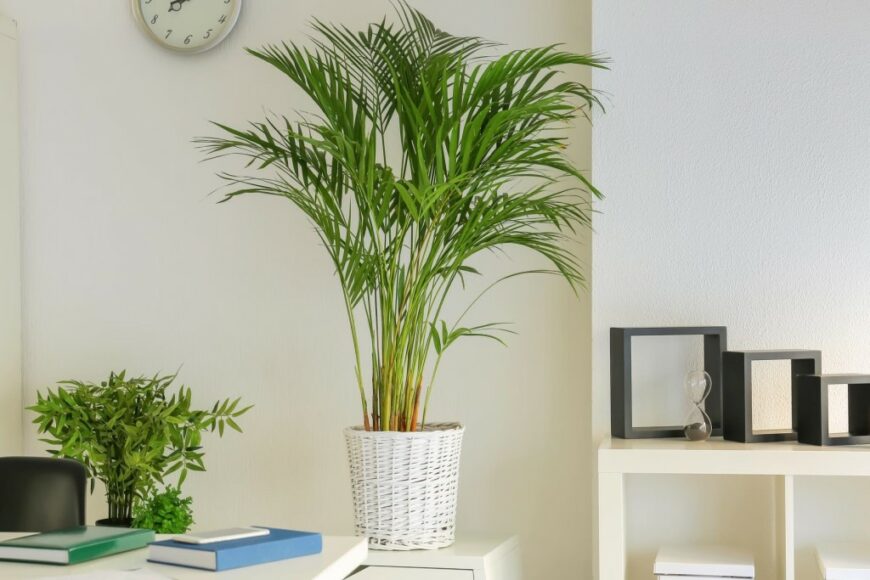
 Name: Areca Palm, Golden Cane Palm, Butterfly Palm, Yellow Palm, Bamboo Palm
Name: Areca Palm, Golden Cane Palm, Butterfly Palm, Yellow Palm, Bamboo Palm Family: Arecaceae
Family: Arecaceae Origins: Madagascar
Origins: Madagascar Humidity: Prefers high humidity (50-60%), but can tolerate lower humidity levels
Humidity: Prefers high humidity (50-60%), but can tolerate lower humidity levels Location: Bright, indirect light
Location: Bright, indirect light Soil: Well-draining potting mix
Soil: Well-draining potting mix Pests and diseases: Spider mites, mealybugs, scale insects, fungal diseases
Pests and diseases: Spider mites, mealybugs, scale insects, fungal diseases Care: Water when the top 2 inches of soil are dry, fertilize monthly during the growing season, mist the leaves regularly to increase humidity
Care: Water when the top 2 inches of soil are dry, fertilize monthly during the growing season, mist the leaves regularly to increase humidity Height of growth: Up to 8 feet tall indoors
Height of growth: Up to 8 feet tall indoors Blooming: Does not bloom indoors
Blooming: Does not bloom indoorsAreca Palm, scientifically known as Dypsis lutescens, stands as a testament to the perfect blend of elegance and functionality in the realm of indoor plants. Revered for its graceful fronds and exceptional air-purifying capabilities, this tropical beauty has become a favorite among plant enthusiasts. In this comprehensive guide, we will explore the essentials of caring for the Areca Palm, ensuring that it not only survives but thrives in your indoor space.
Areca Palm Care Basics
a. Light Requirements
Areca Palms are natural sun lovers, but they prefer indirect light to avoid leaf burn. Position your plant in a bright, well-lit area without exposing it to direct sunlight. Finding that sweet spot ensures the vibrant greenery that characterizes a healthy Areca Palm.
b. Watering Tips
Achieving the right balance in watering is key to Areca Palm care. Keep the soil consistently moist but not waterlogged. Adjust your watering frequency based on environmental factors such as humidity and temperature. Allow the top inch of soil to dry out before the next watering, preventing root rot and ensuring optimal growth.
c. Soil Preferences
Choosing the right soil is crucial for the well-being of your Areca Palm. Opt for a well-draining potting mix enriched with organic matter. Regular repotting every 1-2 years helps refresh the soil, providing essential nutrients for sustained health and growth.
Propagation Guide
Introduction to Propagation
Understanding how to propagate Areca Palms opens up a world of possibilities for expanding your indoor green haven. Whether you want to share the joy of plant parenting or simply cultivate more Areca Palms, the following steps will guide you through the process.
Steps for Propagation
- Gather Supplies
- Sharp knife, rooting hormone, and pots.
- Select Healthy Offshoots
- Identify mature, healthy offshoots for propagation.
- Prepare Potting Mix
- Use a well-draining mix to encourage root development.
- Cut and Treat Offshoots
- Make clean cuts and apply rooting hormone to enhance success.
- Plant in Pots
- Place treated offshoots in pots, water lightly, and cover for humidity.
Troubleshooting Common Issues
- Yellowing Leaves
- Overwatering or insufficient light. Adjust accordingly.
- Brown Tips
- Low humidity or water quality issues. Increase humidity and use distilled water.
- Pests
- Spider mites and scale are common. Use neem oil or insecticidal soap.
Final Words
In conclusion, the Areca Palm offers not just visual appeal but also a breath of fresh air in your living space. By mastering the basics of care, propagation, and troubleshooting, you can ensure that your Areca Palm becomes a flourishing testament to the joys of indoor gardening. Share your experiences, ask questions, and let the beauty of Dypsis lutescens enrich your home. Happy gardening!

